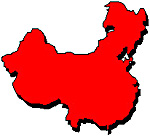 The domestic turmoil in China that began in 1966 and continued until Chairman Mao Zedong's death in 1976 is known as the Great Proletarian Cultural Revolution. As one of the most wrenching and complex, yet probably least understood mass movements of the
20th century, the Cultural Revolution has acquired a bewildering variety of interpretations.
The domestic turmoil in China that began in 1966 and continued until Chairman Mao Zedong's death in 1976 is known as the Great Proletarian Cultural Revolution. As one of the most wrenching and complex, yet probably least understood mass movements of the
20th century, the Cultural Revolution has acquired a bewildering variety of interpretations.
The most common is that it was a simple power struggle, a purge of the so-called 'Rightist' factions in the Chinese Communist Party and government by the 'radical Puritan' factions led by Chairman Mao Zedong. This explanation is adequate when examining the power shifts at the very top, but does not reflect the fact that at street level the Cultural Revolution was also a popular uprising against the entrenched authority and bureaucracy of the Party and government.
Why did it happen? Why would Mao, the very man who had led the Party to victory in 1949, engineer a revolt against the political structure he had created?
Origins of the Cultural Revolution
In 1959, the revolutionary process that had created the People's Republic of China was underway. The Communist Party had come to power in 1949, achieving the immediate political goal of the revolution. The entire economy was being reorganized under the People's Commune system and all industrial and commercial concerns had been nationalized, thus fulfilling the revolution's economic goal. From Mao's point of view, the final step in carrying out the revolution was to transform the Chinese people themselves through a cultural purification. This would create the semi-mythical 'New Socialist Man' and prevent the establishment of a rigid class system within the Party and government, warning signs of which were already apparent.
Mao's opponents were popularly called 'Rightists'. Within the Party and the state administrative bureaucracy, there were factions who held that Mao's ideas had been good for conducting an agrarian revolution but were inapplicable to the operation of a modern state. To them, it was undesirable to let politics and ideology decide everything, and much more necessary to create social stability (in turn allowing industrialization and planned economic development) through building a professional class of managers and civil servants. During the Cultural Revolution itself, the definition of 'Rightist' changed so often it quickly became meaningless, but was generally taken to mean someone who behaved in an authoritarian manner, made decisions without consulting 'the Mass Line', used their station in the Party or the workplace to get special privileges or to protect like-minded colleagues, or promoted the idea of granting financial incentives based on performance or production. The individuals leading Rightist factions would prove to be Mao's main adversaries during the Cultural Revolution and included such major political and bureaucratic figures as his apparent successor Liu Shaoqi (Head of State), Deng Xiaoping (First Party Secretary), Chen Yi (Foreign Minister), Peng Dehuai (Defence Minister) and Peng Chen (Mayor of Beijing).
Mao realized that in order to reform the Party and bureaucracy, he would need to create power bases outside it. The most important would be the People's Liberation Army (PLA). In 1959 Mao accused Peng Dehuai (who had been vocally critical of Mao's policies) of 'anti-Party activity' and replaced him with Lin Biao, a man even more radical in temperament than himself. Under Lin, the role the PLA would play in Chinese politics and society would change drastically. Lin gave the PLA an egalitarian look by abolishing ranks and insignia and replacing the Russian-style uniforms with the 'green pajama' suit. He ensured that Mao would have the political loyalty of the military through organizational changes and political indoctrination. He edited and wrote a preface to Quotations from Chairman Mao, and made its study compulsory for all members of the PLA. This, the famous 'Little Red Book', would become the Bible of the Cultural Revolution, and the sight of huge crowds waving this book and chanting slogans from it would become one of its most enduring images. In 1964 the 'Learn from the PLA' propaganda campaign began.
The PLA was held up as the country's best example of correct thinking, revolutionary spirit, and dedication to Maoism. Hundreds of 'soldier heroes', both real and fictional, were displayed as examples of socialist zeal. Mao also worked to secure support from outside the military. The Socialist Education Movement was used to indoctrinate young people, especially i n rural areas, with his ideas. This program was most active from 1963-66 and was aimed at elementary and middle school students (ages 12 to 14), who would later form the majority of the membership of the Red Guards. Finally, Mao allowed a 'cult of personality' to develop around himself. Even though he had technically retired as Head of State in 1958 and was Chairman of the Party in name only, Mao was still the undisputed leader of China to the great majority of the Chinese people. He would trade on this strength throughout the difficult years ahead.
The Great Proletarian Cultural Revolution China
Back to Cry Havoc #18 Table of Contents
Back to Cry Havoc List of Issues
Back to MagWeb Master Magazine List
© Copyright 1996 by David W. Tschanz.
This article appears in MagWeb (Magazine Web) on the Internet World Wide Web. Other military history articles and gaming articles are available at http://www.magweb.com